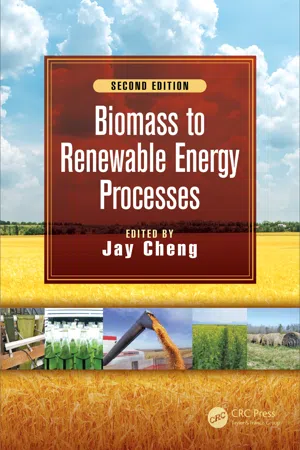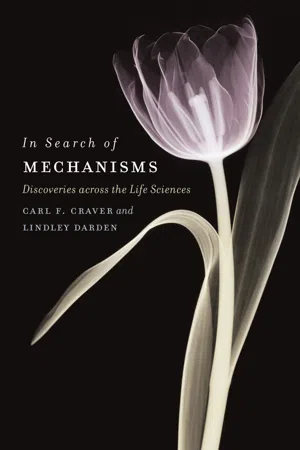Biological Sciences
Biological Processes
Biological processes refer to the series of activities and events that occur within living organisms to maintain life. These processes encompass a wide range of activities such as metabolism, growth, reproduction, and response to stimuli. They are fundamental to understanding the functioning and behavior of living organisms at the molecular, cellular, and organismal levels.
Written by Perlego with AI-assistance
Related key terms
4 Key excerpts on "Biological Processes"
- eBook - ePub
- Jay Cheng(Author)
- 2017(Publication Date)
- CRC Press(Publisher)
5Kinetics and Microbiology of Biological Processes
Jay J. Cheng North Carolina State UniversityCONTENTS
5.1 Introduction of Biological Processes 5.2 Kinetics of Enzymatic Reactions 5.2.1 Mickaelis–Menten Equation 5.2.2 Inhibition Kinetic Models 5.2.2.1 Substrate Inhibition 5.2.2.2 Product Inhibition 5.2.2.3 Competitive Inhibition 5.3 Microbiology of Biological Processes 5.3.1 Microorganisms 5.3.2 Microbial Growth 5.4 Ideal Bioreactors 5.4.1 Batch Bioreactor 5.4.2 Continuous Bioreactors 5.4.2.1 Tubular Bioreactor or Plug Flow Reactor (PFR) 5.4.2.2 Continuously Stirred Tank Reactor (CSTR) 5.5 Examples 5.6 Problems References5.1 Introduction of Biological Processes
Biological conversion of biomass to renewable energy products involves biochemical reactions that convert organic substrates into products that can be utilized for energy production. For example, sugars, starch, and cellulose can be converted to bioethanol or biobutanol through a series of biochemical reactions; organic wastes can be converted to methane or hydrogen through anaerobic digestion. The biomass that can be utilized for biological conversion include sugar crops (sugarcane, sweet sorghum, and sugar beet), grains (corn, wheat, rice, barley, etc.), trees, agricultural residues (corn stover, wheat straw, etc.), grasses, and organic waste materials from municipalities, agriculture, and industries. A biological process usually consists of a series of elementary biochemical reactions catalysed by enzymes, or enzymatic reactions. The overall process can be expressed as follows: - eBook - ePub
Teaching Biology in Schools
Global Research, Issues, and Trends
- Kostas Kampourakis, Michael J. Reiss(Authors)
- 2018(Publication Date)
- Routledge(Publisher)
Complex systems are prevalent in many scientific fields, and at all scales—from the micro scale of a single cell (such as a human fertilized egg) to macro complex systems such as cities or ecosystems (Yoon et al., 2017). In the field of biology, complex systems are found within individual cells, in which complex molecular networks connect signals from the extra-cellular environment to intracellular responses (Chasman et al., 2016). They are also found in individual organisms at the level of physiology, maintaining homeostasis in a variety of different dimensions, like blood sugar and body weight (Rosenbaum & Leibel, 2016). On an even larger scale, interactions between organisms form additional complex systems at the level of biological societies, such as social insect colonies (ants, for example), which are formed by interactions between organisms, each of which is a complex system of its own (Greenwald et al., 2015). Such natural systems are typically dynamic and are often held in states of equilibrium with other interdependent systems, and the interactions within and between them can be unpredictable. Disturbing this web of interconnections can have major implications, as effects cascade across associated networks (Stewart, 2012). Understanding the complexity of natural systems is therefore crucial to a proper understanding of what they are and how they work.Complex systems are comprised of sub-systems, exhibiting outcomes that arise from the interactions between their structures. These outcomes are the results of causal elements participating in causal event chains that vary in temporal and spatial dimensions (Keynan et al., 2014). Thus, a complex system can be generally described as an entity consisting of a large number of structures, at different levels of organization, in which various processes occur. A complex system functions through the mutual interaction of its various components, which work together to bring about a singular function. The interactions within the system are influenced by feedback loops and are usually nonlinear (Ladyman et al., 2013). - eBook - ePub
Progression in Primary Science
A Guide to the Nature and Practice of Science in Key Stages 1 and 2
- Martin Hollins, Maggie Williams, Virginia Whitby(Authors)
- 2013(Publication Date)
- David Fulton Publishers(Publisher)
Chapter 2 Life Processes and Living ThingsIntroduction
Life processes and living things is an area which provides a constant source of fascination for children as they explore the natural world around them. Investigating the living world provides an enormous range of opportunities for developing investigative skills in science, fuelled by children's natural curiosity and their need to make sense of the world around them.This chapter looks at this wealth of material from two approaches:- characteristics of living things;
- environment.
Although we are presenting the chapter as two main areas of exploration, this separation risks loss of meaning. To maintain a coherent whole within this very wide-ranging area, we can identify several main strands which represent the major concepts encountered during any investigation of living things. These concepts will provide useful signposts to refer to throughout the chapter. Misconceptions can easily arise when living things are studied in isolation without taking these strands into consideration. For example, a study of seed growth may involve opportunities to observe and record aspects of the life cycle and patterns of growth. Using the seven strands in Figure 2.1 , a fuller investigation could be achieved, as shown in Table 2.1 .The basic unit of life — the living cell
To have an understanding of life processes, it is useful to know something about the units which make up living material and the way in which these units combine to form larger structures responsible for carrying out specific functions. The basic unit is the cell. There is no such thing as a typical plant or animal cell, because they can vary in shape or size depending on their function, although all cells share certain characteristics. Figure 2.2 highlights the similarities and differences between plant and animal cells.Figure 2.1 Major concepts in living thingsHumans are made of millions of cells, each cell carrying out essential life processes. As animals increase in complexity from the single-celled Amoeba, cells capable of a specific function become grouped together to form organs. The nervous system, heart, liver, kidneys and bones are all organs made up of the individual units of life. The diversity of cell type found within the plant and animal world is enormous (see Figure 2.3 - eBook - ePub
In Search of Mechanisms
Discoveries across the Life Sciences
- Carl F. Craver, Lindley Darden(Authors)
- 2013(Publication Date)
- University of Chicago Press(Publisher)
2 BIOLOGICAL MECHANISMS WHAT IS A MECHANISM?Mechanisms are how things work, and in learning how things work we learn ways to do work with them. Biologists try to discover mechanisms because mechanisms are important for prediction, explanation, and control.Biologists seek mechanisms that produce, underlie, or maintain a phenomenon. Stated most generally:Mechanisms are entities and activities organized such that they are productive of regular changes from start or set-up to finish or termination conditions .Below we elaborate upon the different parts of this characterization, one at a time, to bring the target of the search for biological mechanisms more clearly into view. As we elaborate throughout the book, the intended target of the search—mechanisms—shapes the process by which biologists try to find them.MACHINES VERSUS MECHANISMSIt is often easy to understand how human-made machines work. One gear turns, and its teeth mesh with another gear, which turns too. This was an appeal of the seventeenth-century clockwork universe: it was understandable, given the analogies to machines of the day. And sometimes it is also easy to understand biological mechanisms; they have parts and are driven by activities that are machinelike. A DNA double helix opens like a zipper and its bases mesh with other bases that have complementary shapes (and charges).However, biological mechanisms are often quite unlike machines. A machine is a contrivance, with preexisting, organized, and interconnected parts. Paradigm examples are the mechanical clock, the water pump, the internal combustion engine, and the computer. Biological mechanisms have been tinkered together under mutual constraints through evolution by natural selection and through development. Their parts may be synthesized on the fly and rapidly degraded or they may be more stable. But not all the parts are necessarily in place prior to the operation of the mechanism. The blueprint of the typical biological mechanism is decidedly messier than the blueprint for even complicated machines.
Learn about this page
Index pages curate the most relevant extracts from our library of academic textbooks. They’ve been created using an in-house natural language model (NLM), each adding context and meaning to key research topics.



